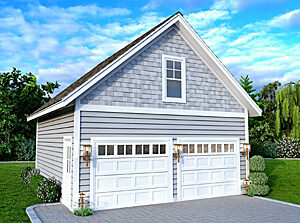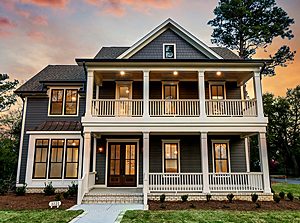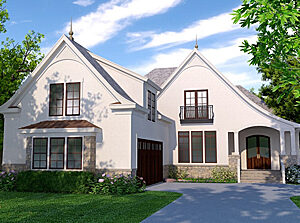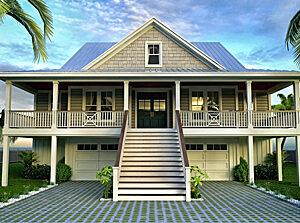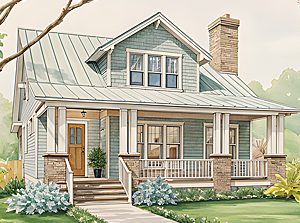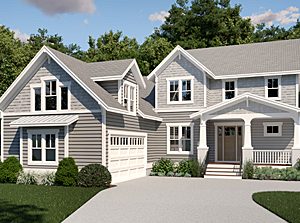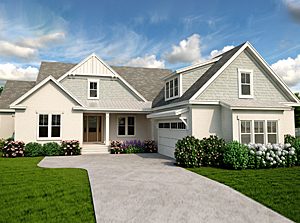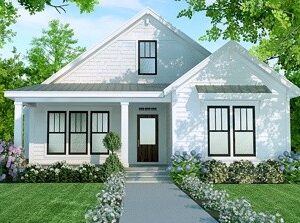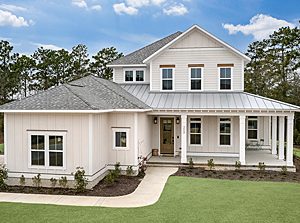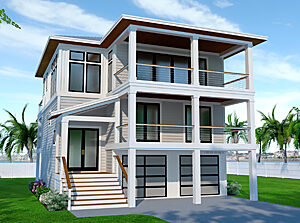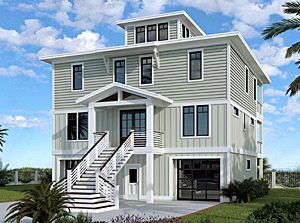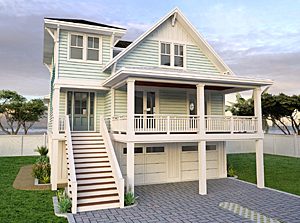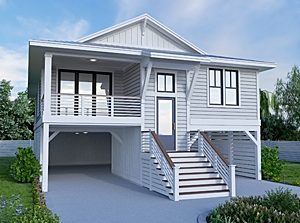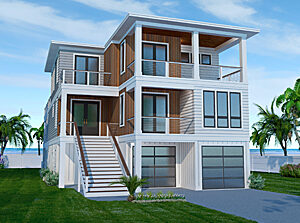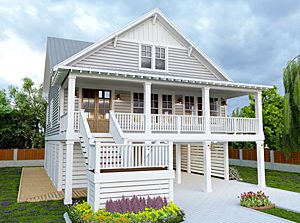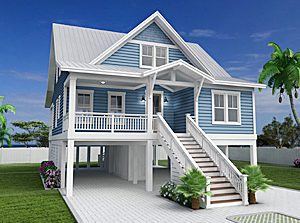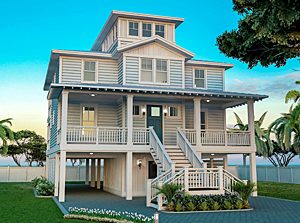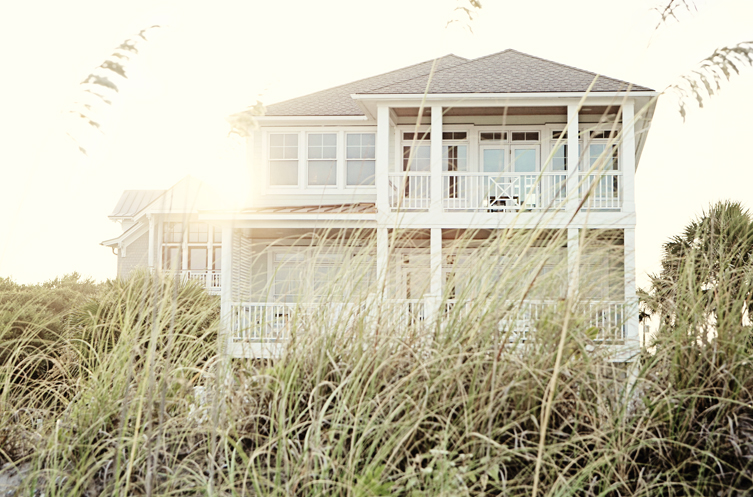I’m sure you’ve spent many years picturing it, the sound of gentle waves, salty breeze blowing in the air, and coastal living sounds like magic.
And now, after all this time, you are ready to start building the coastal home of your dreams.
As relaxing as a beachside escape may sound, the process of ideating and building a home from scratch can sound stressful and daunting.
Don’t worry, in this blog article, we will guide you through everything you need to know about building your coastal home, from finding the right lot to picking a house plan, and choosing the right materials.
At SDC House Plans, we specialize in creating house plans, and in this blog article we will give you a brief overview of what to expect during this process.
So, let’s dive into the ins and outs of coastal living and what you need to know to build that beach house of your dreams!
Table of contents
- 5 Must-Knows Before Buying A Coastal Lot
- How to Find The Perfect Beach House Plan
- The Best Materials for Building a Beach House
5 Must-Knows Before Buying A Coastal Lot
Before you get excited about house plans and construction, you need to choose the right lot.
If you don’t choose your building lot correctly, it could serve as the bottleneck for every part of the home-building process. Here are five things to consider when finding the perfect lot.
#1 Local Zoning
Coastal areas are subject to specific zoning regulations, especially those aimed at preserving the environment and sure sustainable development.
Before purchasing a lot, understand the zoning laws for that area and be aware of any setback requirements. Some common ones being
- The minimum distance between the edge of the property and the water’s edge
- Protection of dunes, wetlands, and other environmentally sensitive areas
- Height restrictions to prevent visual obstruction and maintain scenic views
- Impervious coverage limits in some areas
- May designate easement areas for utilities draining or other purposes restricting construction
To find the local zoning map for your property simply search for “local zoning map [your city],” and a few should pop up.
#2 Flood Zones
Understanding flood zones is crucial for coastal properties due to the increased risk of flooding. There are several different flood zones the lot can be categorized as, each with its own risk of flooding.
Determine what flood zone your lot is in and consider potential impacts such as property insurance costs or risks of damage.
#3 Utilities and Infrastructure
Evaluate access to utilities and infrastructure such as water, electricity, sewage, road access, and internet. Ensure reliable access to these essential services for comfortable living.
Use search tools like InMyArea.com to view what utilities service your area.
#4 Resilience and resale value
Assess the environmental resilience of your chosen lot to mitigate risks and ensure the longevity of your home. Properties with strong environmental resilience tend to have higher resale values, making them a wise investment for long-term sustainability and profitability.
You can always consult with local professionals like real estate agents or local officials for more information.
#5 Insurance and Taxes
Coastal properties may require specialized insurance coverage due to their increased exposure to natural disasters.
Research insurance options and property tax rates in the area to understand the financial implications of homeownership.
Zillow has a great tool for estimating property taxes based on Zip Code and estimated home value.
How to Find The Perfect Beach House Plan
Selecting the perfect coastal house plan is no easy task. There are many beach-style homes to choose from, all with their unique features and strengths. When choosing the right house plan important to consider the following criteria.
Consider Weather Resistance and Flood Protection
The goal of picking your beach house design is so that your house stays near the water but not under it.
The majority of coastal homes are designed with flood protection and the elements in mind. Many homes have varying measures in place, such as foundation type and default material choice.
Maximizing Views and Natural Light
Another goal for living at the beach is to be able to see it!
Luckily many homes are designed to have lots of windows for natural light and different variations of wrap-around porches, decks, and outdoor spaces.
Reverse house plans are especially good for maximizing coastal views as the main living area is on the top floor.
On the SDC House Plans website, we offer many different collections for rear view, front view, and reverse home designs depending on the orientation of your lot and location.
Select Suitable Foundation Options
Choose foundation options like stilts, piers, or pilings that elevate your home above potential floodwaters and minimize damage from coastal storms.
Opt for designs that incorporate elevated foundations and piling construction to ensure your home is resilient to coastal hazards and built to withstand the test of time.
Explore Diverse Floor Plans and Features
Explore a diverse range of coastal house plans to find the perfect fit for your lifestyle and preferences.
Consider factors like size, layout, and interior features such as gourmet kitchens, spacious bedrooms, and inviting outdoor living areas. Seek designs that offer open floor plans, luxury coastal living amenities, and flexible spaces to accommodate your unique needs and desires.
You Can Always Customize it!
Of course, all house plans are designed meticulously, but what is perfect for someone else might not be perfect for you. That is why it is important to remember that floor plans can be modified. At SDC House Plans not only do we design all of our floor plans but modify them in-house to meet your specific needs.
The Best Materials for Building a Beach House
Now that you have your house plan picked out, it is time to take a second look at the material you want to build your home with. Like any home, the materials you choose are heavily affected by external factors like climate and weather conditions. For coastal homes, it is important to have materials that can sustain, high heat, moisture, and corrosion resistance. This is important for elements inside your home but especially the external part of your home. Below is a list of the most common materials used to build coastal homes.
Window Options for Coastal Homes
Impact Resistant Windows – These are designed to withstand high winds and flying debris during storms. They are constructed with laminated glass and reinforced frames to provide superior strength and durability.
Vinyl windows – popular in coastal areas due to their resistance to saltwater corrosion and low maintenance requirements.
Aluminum-clad windows – offer durability and weather resistance, making them ideal for coastal environments. The aluminum exterior protects against corrosion, while the wood interior adds warmth and charm to the interior space.
Window Options for Coastal Homes
Metal Roofing – is a popular choice for coastal homes due to its durability and resistance to high winds and salt spray. It comes in various styles, including standing seam, corrugated, and metal shingles, and can last for decades with minimal maintenance.
Composite Roofing – such as asphalt shingles and synthetic slate, offers a cost-effective and durable roofing solution for coastal homes. They provide excellent weather resistance and come in a wide range of colors and styles to suit any architectural design.
Concrete Roof Tiles – known for their durability and resistance to fire, wind, and saltwater corrosion. They come in various profiles and colors, mimicking the appearance of traditional clay or slate tiles while offering superior performance in coastal environments.
Doors Options for Coastal Homes
Fiberglass Doors – are highly resistant to moisture, rot, and corrosion, and come in a variety of styles and finishes, including wood-grain textures.
Steel Doors – offer unmatched security and durability, making them a popular choice for coastal homes. They are resistant to warping, cracking, and corrosion, making them ideal for withstanding harsh coastal conditions.
Aluminum Doors – are lightweight, durable, and resistant to corrosion, making them suitable for coastal environments. They come in a variety of styles, including sliding glass doors and French doors, to enhance both aesthetics and functionality.
Best Siding for Coastal Homes
Fiber Cement Siding – a durable and low-maintenance option that is resistant to rot, moisture, and pests, making it ideal for withstanding the elements. It comes in a variety of textures and finishes, including wood-grain and smooth, to suit any architectural style.
Vinyl Siding – is a popular choice for coastal homes due to its affordability, versatility, and low maintenance requirements. It is resistant to rot, moisture, and pests, making it a durable option for withstanding coastal conditions. It comes in a wide range of colors and styles to complement any design aesthetic.
Cedar Shingles – offer natural beauty and durability, making them a timeless choice for coastal homes. They are resistant to rot, insects, and moisture, making them ideal for withstanding harsh coastal conditions. Cedar shingles age gracefully, developing a weathered patina over time that adds character to the home’s exterior.
Floors for Coastal Homes
Porcelain Tile – a popular choice for coastal homes due to its durability, moisture resistance, and low maintenance requirements. It comes in a variety of colors, patterns, and textures to suit any design aesthetic and can be installed indoors and outdoors for a seamless transition.
Engineered Hardwood – offers the beauty of natural wood with enhanced durability and moisture resistance, making it ideal for coastal environments. It is constructed with multiple layers of wood veneer and a stabilizing core to withstand fluctuations in temperature and humidity.
Luxury Vinyl Plank – a cost-effective and durable option for coastal homes. It mimics the look of hardwood or stone flooring while offering superior resistance to moisture, scratches, and wear. LVP comes in a variety of colors and textures to match any design aesthetic and can be installed in virtually any room in the home.
Paint for Coastal Home Exteriors
Acrylic Exterior Paint – durable and long-lasting option for coastal homes. It offers excellent weather resistance, UV protection, and color retention, making it ideal for withstanding the harsh coastal environment.
Marine-Grade Paints – formulated to withstand saltwater exposure and harsh coastal conditions. They provide superior durability, corrosion resistance, and UV protection, making them ideal for coastal homes located near the ocean.
Elastomeric Paints – flexible, waterproof coatings that provide excellent protection against moisture, cracking, and peeling. They are ideal for coastal homes exposed to high humidity, salt spray, and extreme weather conditions, ensuring long-lasting beauty and protection.
Conclusion
Building a coastal home is an exciting process, but it requires careful planning and consideration. By working with experienced professionals and staying organized, you can ensure your coastal home is completed on time and meets your expectations for quality and craftsmanship.
Hopefully after reading this guide, you should have a sense of what work it takes to build a coastal home from the ground up. There are many things to check and be aware of but the result is something that can’t be beaten, a coastal life on the beach.
Regardless of where you are right now in your home-building journey, it is always good to be prepared and be inspired. Check out our collection of coastal house plans here, we have tons of options to choose from.
If you have any comments or feedback feel free to add them in the comments section or contact us if you have any questions about our house plans.



